
Bee Hive Pests
Small Hive Beetles
Aethina tumida, the small hive beetle (SHB) originally from sub-Saharan Africa, has become invasive in many other parts of the world where European honey bees are kept. Adult beetles are about ¼” long and dark reddish brown in color. They are small enough to often evade guard bees and enter hives.

Garry Fry, National Bee Unit, Food and Environmental Research Agency, UK, nationalbeeunit.com
As long as the colony is healthy and the honey bee population is strong, SHB adults do not cause damage, but mainly constitute a nuisance to the bees. Beetles avoid bees by hiding in inaccessible niches in the hive, and depositing eggs in cracks and crevices. A strong bee colony can usually remove limited eggs or beetle larvae, but if the bee population is insufficient, beetle larvae can quickly overwhelm the hive. This can be due to a gradual or sudden reduction in bees because of diseases, mites, queenlessness, swarming, or beekeeper manipulations such a colony splits.
Hive beetle larvae are scavengers, feeding on pollen, honey bee brood, or even their own dead. When feeding on honey, beetles introduce a yeast that causes honey to ferment and run out of cells, and the colony is referred to as “slimed.” A high level of slime in a heavily infested colony may cause the remaining bees to abscond and completely abandon the hive. The odor of fermenting honey signals that the colony is weak, attracting more adult beetles from outside.
Beetle larvae can also be destructive pests of the honey house, where combs are stored for extraction, and no longer protected by bees. Under ideal conditions, larvae can hatch from eggs in untended supers and ruin a honey crop within just a few days. Honey should be extracted within a two days of removing it from the hive, and wet cappings should be covered or frozen until they can be processed.
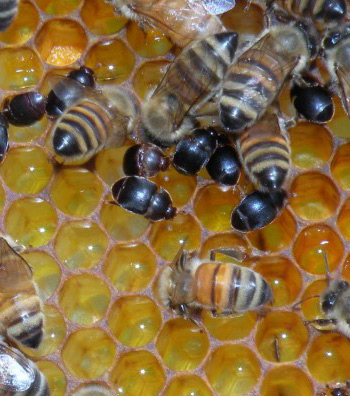
Small hive beetle adults are easily recognized.
Photo by Jessica Louque, Smithers Viscient (bugwood.org)

Beetle larvae have well-developed legs and rows of spines. They may be too small to notice until they have become a serious problem.
Photo courtesy Pest and Diseases Image Library (bugwood.org).
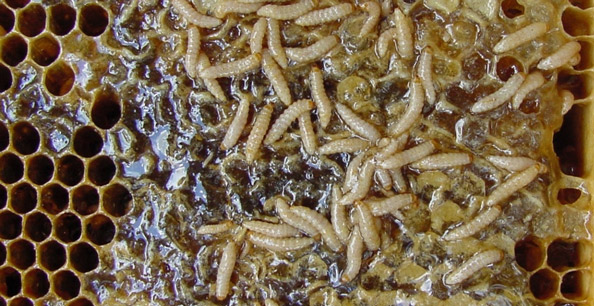
Beetle larvae on a “slimed” honey comb.
Photo by James D. Ellis, University of Florida (bugwood.org).
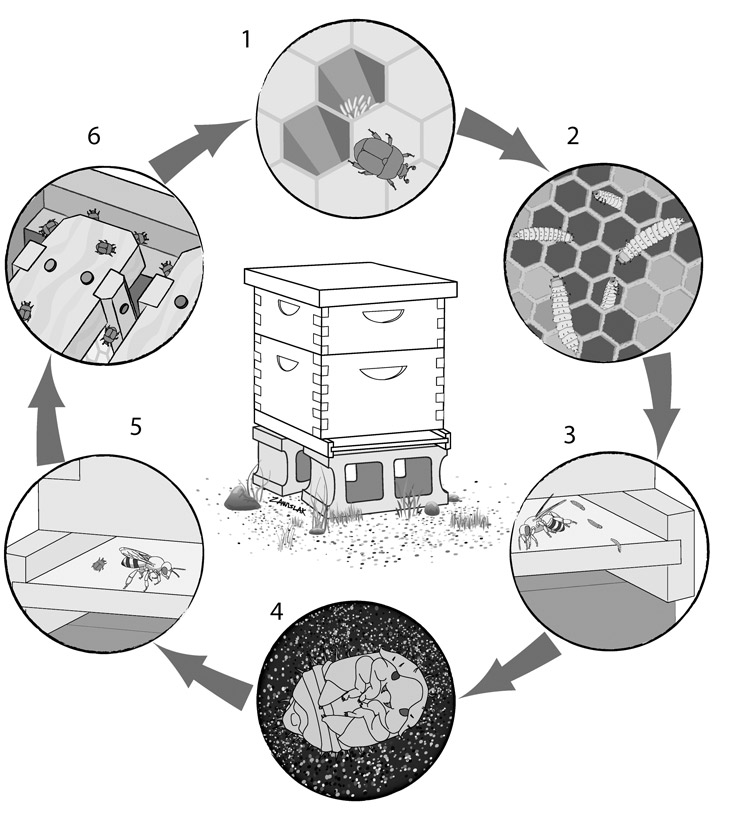
The Small Hive Beetle Life Cycle
- Female beetles deposit masses of eggs in crevices around the hive, or directly on pollen or brood combs. Beetles may puncture the wall or capping of a sealed cell and deposit eggs inside.
- Eggs hatch in 2-4 days, after which larvae immediately begin to search for food. The larvae may feed on pollen, honey or bee brood and eggs.
- Beetles typically complete their larval development within 7-10 days. The mature “wandering” larvae exit the hive and burrow into the soil.
- Beetle larvae pupate in the top 4” of soil, on average. Pupation takes 3-6 weeks to complete, depending on temperature and soil moisture.
- Newly emerged adult beetles locate host bee colonies by their odor. They are strong fliers, and can disperse to other hives easily.
- Adult beetles avoid the light, and tend to congregate in spaces inaccessible to honey bees. They may be observed running inside lids, on walls or across frames during hive inspections.
If bees do not consume pollen patties rapidly, SHB will readily utilize this food for oviposition. Do not add protein supplements to hives that will not immediately eat them. Any patty found to contain SHB larvae should be removed and discarded immediately.
Beetle larvae feed for 7-10 days, then exit the hive to pupate in the top 4” of soil. Pupation takes 3-6 weeks, depending on soil moisture and temperature. Newly emerged adults locate hives by odor. They are strong fliers and can easily disperse to seek new hives. The best defense against SHB is strong colonies, which reduce mating and oviposition by adult beetles.
Physical or mechanical traps and barriers can be used to reduce the population of adult beetles in the hive, and limit their reproduction. Many types of traps are available that fit inside a hive, or may modify or replace parts of the hive itself. No traps completely eliminate all SHB, but they can be used as part of an overall IPM strategy.
Physical barriers (Beetle Jail Entrance Trap®, Beetle Baffle®) can exclude or reduce the number of beetles that enter a hive while allowing bees to pass freely. These devices do not remove or restrict SHBs that are already inside. Beetles are able to fly, even in the hive, and can bypass some barriers. Also, they are only effective if the rest of the hive is in good repair, without gaps or cracks that allow beetles to enter above the barrier.
Many traps take advantage of the beetles’ instinct to hide from bees inside the hive, causing them to drown in oil or soapy water. Vegetable oil must be changed periodically, or it becomes rancid; mineral oil lasts longer, but is more costly. Soap or detergent is added to water to break the surface tension of the water and ensure that SHB sink and drown.
Adult beetles can fit through the standard 1/8” mesh in a screen bottom board. Placing a tray below this screen, filled with oil or soapy water, can trap and kill SHB. These trays will collect dropped pollen and other debris from the hive, as well as dead beetles, and should be cleaned out regularly. If soapy water is used, it can evaporate quickly in hot weather, and if not replaced, the debris in the dry tray can quickly become a source of food and a breeding ground for additional small hive beetle larvae.
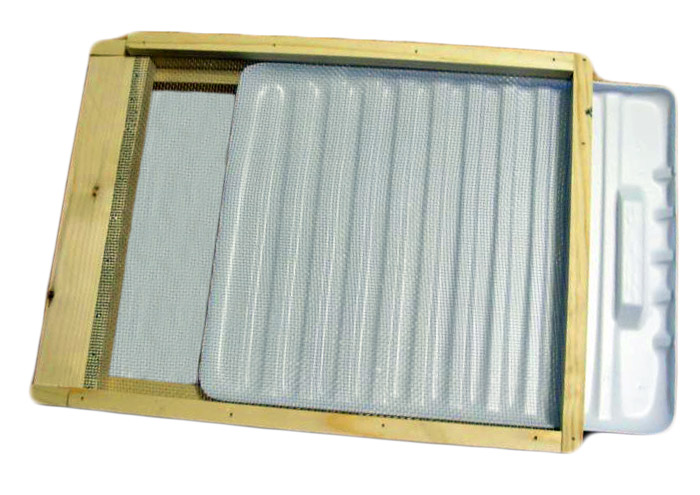

Oil trays beneath hives can be effective traps when used properly. If allowed to accumulate pollen and debris, empty trays can become convenient feeding and breeding sites for more small hive beetles inside of the hive.
Numerous traps fit between frames and have openings that permit SHB, but are too small to for bees (AJ’s Beetle Eater®, Beetle Blaster®, Beetle Jail Baitable®). Adult hive beetles enter these traps to hide from bees, and drown. Some designs also have a compartment to hold a bait, such as apple cider vinegar, which mimics the attractive odor of fermenting honey.
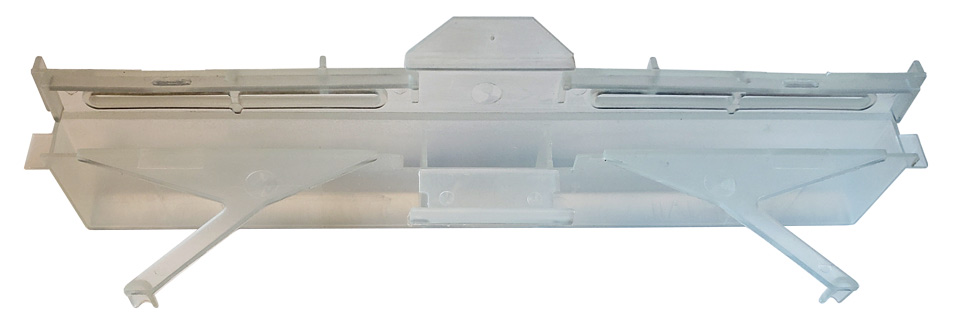
This trap fits over the top of a frame, and has openings that permit adult beetles to enter, but excludes bees. It is filled with oil to kill beetles, and has a compartment for an attractant, such as apple cider vinegar.
If a hive has been overrun by SHB larvae, beekeepers may treat the soil beneath and around their bee hives with permethrin (GuardStar®) to prevent pupating SHB from emerging to infest additional hives. If necessary, mow ground cover and remove water sources around hives prior to treatment. Mix product according to label instructions and apply in late evening when few bees are active. Thoroughly drench soil 18-24” in front of hives with a sprinkler can. Never use a pressurized sprayer, and avoid product contact with bee hive equipment.
Some species of entomopathogenic nematodes, such as Heterorhabditis indica and Steinernema carpocapsae, are commercially available and may help suppress SHB populations by killing pupae before they emerge from the soil. Mix the nematode substrate with water and apply directly to soil beneath and around hives. Success depends on soil type and moisture, as well as a consistent supply of beetle pupae to support the living nematode population. In general, soils that best support SHB development will likely support nematodes. While conclusive research is lacking on how well nematodes persist through extremely dry or cold periods in different climates, and how often they should be reapplied to soil, they can be used as a component of an overall IPM approach.
Wax Moths & Wax Worms
Two pests, the Greater Wax Moth (Galleria mellonella) and the Lesser Wax Moth (Achroia grisella) are ubiquitous, opportunistic pests. They may be found infesting weak or dwindling bee hives, and can be particular problems in stored combs. Both of these species have similar habits, and management recommendations are the same for both.
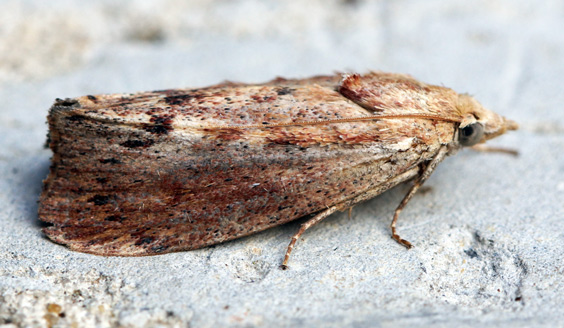
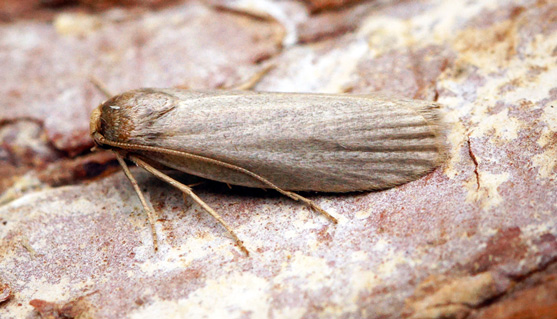
The Greater Wax Moth, Galleria mellonella (left), and the Lesser Wax Moth, Achroia grisella (right) are both destructive pests found in weak hives and stored combs. Photos by Ben Sale (flickr.com/photos/33398884@N03)
Female moths deposit clusters of eggs within crevices in the hive. Eggs can hatch within in a few days, depending on temperature conditions. The larval stage, known as a wax worm or web worm, is the actively destructive form. Larvae burrow through comb, consuming and destroying beeswax, and spinning silk webbing, which is thought to protect the larvae from honey bees. Dark, older combs containing multiple layers of discarded bee cocoons are most attractive to the wax worms. Combs that have only been used for honey storage are much less attractive to wax worms, but it will still be consumed when infestations are large.
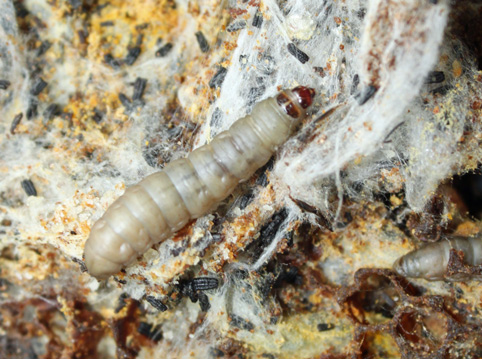
Damage to comb caused by wax worms.
Photo by Rob Snyder (beeinformed.org).
Larvae feed for 6-7 weeks, molting 7 times as they grow up to 1” long. In the final stage they chew out a niche in the wall of the hive or a wooden frame, and spin a protective cocoon for pupation. Cocoons are often found in dense clusters. Pupation time varies with season and temperature, from 6 days to several weeks. Moths do not feed in the adult stage, and live a few days to several weeks. Mating occurs soon after adult emergence, with a single female capable of producing up to 2,000 eggs in her lifetime.
The best defense against wax moths is to keep bee colonies strong, healthy and queenright. Well-maintained hives, without cracks or holes, and full of bees, will best keep out pests such as wax moths.
A strong colony will actively kill and remove individual Galleria adults and larvae. A symptom known as bald brood is sometimes observed, when a wax worm has been detected tunneling through the sealed brood cells, and worker bees uncap cells in a straight line, seeking to remove the caterpillar. These cells are typically not re-capped, but pupae inside should continue to develop and emerge normally.
If found in a weak colony, the supers containing moths and caterpillars can be frozen 48-72 hours to kill them. If damage is not severe, the hive body can be placed onto a strong, active colony for the bees to clean and repair combs. If damage is severe, use a hive tool to scrape and clean all damaged frames and boxes, and replace with new foundation. Caterpillars will rarely damage plastic foundation, which can be cleaned and coated with fresh beeswax and reused. Damage to frames or woodenware can be so extensive that it cannot be reused.Drawn combs that have been removed from hives for storage are particularly vulnerable to wax moth damage. If undetected, the progeny from a single female moth can destroy countless boxes of comb. Moths usually avoid comb stored in areas with plenty of sunlight and air circulation, however, this is not always practical for the beekeeper. Boxes of combs can be preserved by freezing or fumigation.
If space is available, entire boxes of drawn combs can be frozen indefinitely. Prior to freezing, boxes can be placed in large plastic trash bags to capture debris, but should not remain sealed in plastic if removed from the freezer, because trapped moisture will promote the growth of mold. Combs containing pollen or honey should be kept frozen or placed into an active colony, or they risk becoming infested with small hive beetles, ants, and other insects that readily feed on this rich source of food.
Because brood combs are far more attractive to wax worms, beekeepers should make efforts to prevent the queen from laying eggs in honey supers. This will reduce the amount of pollen stored there, and prevent a build-up of cast skins and cocoons that attract the Galleria moths. Newly drawn comb that has only been used for honey storage is not nearly as attractive.
Chemical fumigation can be used to kill both moths and larvae, and to protect stored combs, but cannot be used on colonies with live bees, nor should it be used with combs full of honey. Stack up to 5 “deep” or 10 “medium” supers vertically, on a thick pad of newspapers, and seal cracks between boxes with masking tape. Place a piece of paper or cardboard above the frames of the topmost super, sprinkle 3 ounces (4 tablespoons) of paradichlorobenzene crystals (PDB), sold as Para-Moth® or Enoz Moth Ice Crystals®, onto the paper, and closed with a standard bee hive lid.
Moth crystals are not the same as moth balls, which should never be used in beekeeping!
PDB fumes are heavier than air, and will fill the entire stack, killing all stages of caterpillars, and will repel adult moths from entering stored equipment. Use only in a well-ventilated area. Apply to clean, dry supers after honey has been extracted. Never apply to combs containing honey. In warm weather, inspect the stack every 2-3 weeks to ensure that some crystals remain, adding more product if necessary. Wax moths are generally only active during warmer months, and are rarely a problem after the first hard freeze, as long as temperatures remain low. In the spring, moth activity is usually negligible. Unstack all equipment and allow it to air out for 2 weeks prior to use on bee hives.
Another fumigant, aluminum phosphide (Phostoxin®) can also be used to protect stored products, including drawn combs. It is highly effective at killing pests, but also extremely hazardous to humans, and is therefore a restricted pesticide, available for purchase and use only by licensed applicators. Users must read and follow all labels directions carefully!
Ants
While ants can be a common nuisance to beekeepers, few species are destructive pests. They occasionally nest in hive equipment, and may feed on honey or in syrup feeders. Keep hives elevated from the ground, away from contact with the soil. If possible, place hives on a stand with legs, and keep the legs in pool of water or oil. Ants will be unable to cross this moat to enter the hive. Alternately, coat legs of hive stands with petroleum jelly, which will also prevent ants from climbing up. Keep vegetation trimmed down so that ants cannot climb onto hives from tall grass or weeds.
Mice
Rodents will shelter in empty hive equipment, and can destroy combs when they build a nest, as well as bring in debris and leave their droppings. Mice may also nest inside of an occupied hive when bees remain clustered during cold weather. Elevate bee hives from the ground and restrict the size of the opening to discourage mice from entering. Mouse guards are available commercially or can be crafted by beekeepers. Mouse guards should be installed before temperatures fall below 57° and bees begin to cluster, to avoid trapping a mouse inside the hive.

Photo courtesy Brett Kozma, B&K Bees (bkbees.com)
Skunks
Skunks visit bee hives at night, where they will repeatedly scratch at the entrance of the hive. The disturbance draws out a few guard bees at a time, which are eaten. Skunks learn to avoid strong hives, and may return nightly to feed. Some beekeepers construct wire barriers across the entrance of hives, to prevent skunks from reaching the entrance. A length of carpet tack strip across the end of the landing board should keep unwanted paws away from the entrance. Raising hives off the ground also helps keep them out of easy reach of small mammals.

Photo courtesy Chinook Honey Company (chinookhoney.com)
Bears
The largest and most destructive pest of bee hives are bears. These large animals will feed on honey, but protein-rich brood is their preferred food. A curious bear will usually approach at night, knock hives over, and drag or carry frames of food away from the stinging bees to eat. Once they have successfully fed, bears will often return to the same apiary again, causing additional damage.

Photo by Terry Spivey, USDA Forest Service (bugwood.org)
While expensive to install, electric fences are the most effective method to prevent bears from destroying an apiary. Electric fences must be installed and maintained correctly to be effective. Wrapping an electrified wire with raw bacon will entice a curious bear to investigate it, rather than the bee hives inside, and a single shock may be enough to convince a bear to avoid the fenced area completely. State wildlife officials may be able to trap and relocate bears that have become accustomed to people or bee hives.
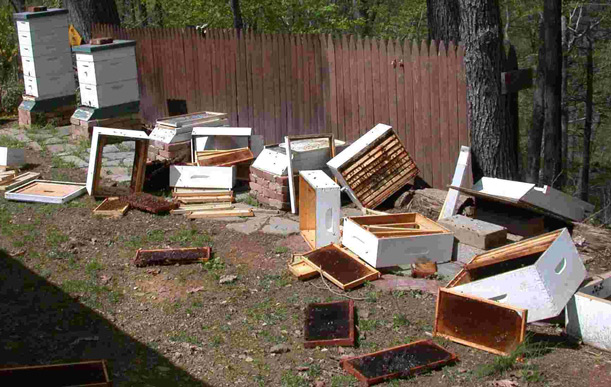
An apiary damaged by bears. Photo courtesy Janet A. Katz.

Click the 'X' to exit fullscreen.